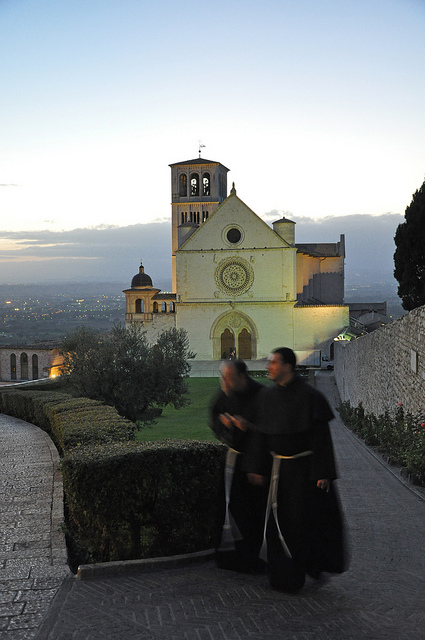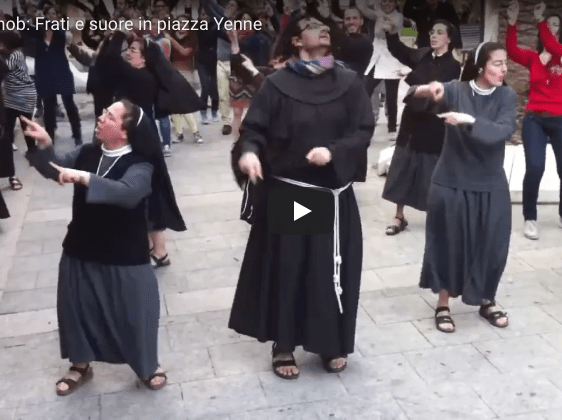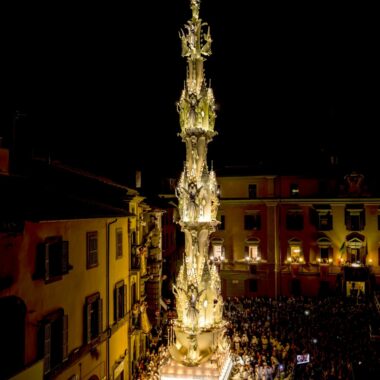The last, documented one took place about two weeks ago in Florence and the video, published as usual on social networks, went viral in a matter of hours: I am not talking of VIPs interviews or dumb acts glorified by the net, as it often happens these days, but of dancing churchmen and women.
So, what happened?
A group of Franciscan Friars gathered in Florence’s Piazza della Signoria for the Missione Giovani Firenze 2015, an event organized on national level, that sees friars and nuns travelling through Italy to get the younger generations closer to their Faith; with a friendly and unpretentious approach, and with the simplicity of word and actions typical of their orders, these men and women have attracted plenty of attention on their initiative, and brought the public eye on new potential forms of evangelization. As we are all children of the 21st century, Missione Giovani 2015 comes complete with hashtags (#liberiperamare) and an anthem, the song “Esci Fuori!” (Come out of there!), to which these impromptu dancing sessions usually take place.
The flash mob in Florence, which happened a couple of weeks ago (October 2015), is only the last in a series of such events that see religious men and women at their centre.
It seems – and I say “seems” because there is a sort of urban legend-like aura around this thing – the first of them took place in Cagliari in 2013, in Piazza Yenne: there, a group of Franciscans and nuns danced away to a techno song (pardon me if I don’t know whether it’s the same one as in Florence) to attract the attention of people, in the hope to encourage them to embrace spirituality.
The video of the first documented “religious” flash mob reached hundred of thousands of views on youtube.
Flash mobs and dancing friars are not the only curious manner the Italian clergy has recently used to keep up with times. In April, the Bishop of Noto, Antonio Staglianò mentioned – singing parts of them – two pop songs by Italian singers Noemi and Marco Mengoni during a homily. Certainly, Staglianò demonstrated to know how to use allegory in his speeches by voluntarily citing easy-to-understand, popular music to explain concepts of a higher depth, yet, was it really a good idea? And are dances in public squares to the rhythms of rave music the way to convince people to open up to Faith?
Of course, the topic is controversial: to some, these are positive examples of a Church that needs and wants to get more popular by “mingling” with the everymen and everywomen of the world: if Mankind likes pop music and dancing, then let us give it to them. To others, these behaviors are largely unacceptable and belittle the sanctity of Faith and spirituality.
One point on which all agree is how these acts have attracted a great deal of attention, as the high count of views and postings on social medias show, but is it the right type of attention?
The matter is well explained by Andrea Carrori in his blog, traditiocatholica, where he discusses the issue at length and intelligently tells us why, in his opinion, this is not the way to go, without in any way accusing, however, the religious protagonists of these events for their actions.
On the contrary, Carrori is quick to underline their intentions are, indeed, worthy of praise, but how the means chosen may be wrong: of course the friars’ flash mobs videos have gone viral, everyone wanted to see them dancing in their habit. However, it is very unlikely this interest brought to an actual rapproachement of people to Faith: let us face it, a dance and a pop song will not make a difference in the heart and soul of a person seeking refuge in spirituality, or contemplating the idea of doing so.
If it is true the Church needs to be more in touch with faithfuls and more aware of social changes and developments; it is also true that it should not loose its own essence and nature while doing it: who seeks support and strength in spirituality and religion wants someone able to communicate, explain, describe the mysteries and beauty of Faith: if approachability is certainly important (we all want to feel comfortable with figures of spirituality, of course), many believe it can be shown in more adequate ways than dancing in the middle of a street.
Carrori mentions in his piece an age-old timor reverentialis (“reverential respect” or “awe”) towards the Church and its people: criticized by atheists and non Christians as one of the many ways Catholicism has not kept up with modernity, in truth, this is crucial to the faithful. To understand what I mean, think of what we all naturally feel for a teacher or a doctor: feeling that way towards them is part of the reason why we trust and believe in them in the first place. The same should work for priests, nuns or monks.
The homily during which mons. Staglianò sang two pop songs. Is this really the best way to get closer to your everyman and everywoman?
I am not talking about sterness, but rather about a behavior and an attitude exuding wisdom and serenity, which makes the faithful – or potential faithful – sense the person on front of them, quite simply, knows what s/he is talking about.
This is the more complex side of the discussion, of course, but there is a simpler and more immediate one to it, too: that of how to attract people’s attention to spirituality and religion the right way. I tend, once again, to agree with Carrori’s point of view here, which is very much that shown to me by more than one man of church, when asked about the religious flash mobs phenomenon.
Throughout the centuries, the Catholic Church as an institution did a lot of highly questionable things (*cough* the Inquisition *cough*), but also stood behind some of the most amazing artistic and philosophical achievements of Western Civilization: why not use those as a point of attraction for people? Why not to offer, for instance, a sacred music concert, performed by young musicians and singers? There are many, extremely talented choirs out there, associated with parishes and churches and a plethora of young performers who would love to play in public. Squares such as Piazza della Signoria would offer a perfect backdrop to these exhibitions, which would certainly attract attention, but of a more appropriate kind.
Andrea Bocelli performs Caccini’s Ave Maria, a famous piece of sacred music, of an incredible, touching beauty.
If it is true the Church needs to rejuvenate itself, it needs to do so, I think, by keeping faithful to its creed and ethics, but also to its formal behavior. It needs, in other words, to keep faithful to its own very nature, as loosing its identity would not gain it more followers and certainly would leave in dire streets those it already has.
I speak as a born and bred Catholic, so forgive me if my point of view sounds biased. I however believe each and every intelligent man and woman agrees in considering any act or behavior misrepresenting one’s identity and nature bound to fail. And this stands true also for the Church.
If the Franciscans of Florence asked my opinion, this is exactly what I would tell them. What I would ask them to do is to tell me about their spiritual calling, about how they hold on to their Faith in spite of all that happens in the world, about how to ease the struggle we all – religious or not – endure every single day of our lives to be better human beings. I would ask them about human’s fear of death, about where we go once we no longer exist in flesh and bones.

passing by (Sarah Sampsel/flickr)
This is what I would ask them. This is where I would expect them to metaphorically take my hand and show me their way of walking this hard, solitary, yet beautiful path we call life.
I sort of can dance at techno music myself: there are plenty of cringy college years photos witness to that, and I think we very much all feel the same way about it, Catholic or not.



























